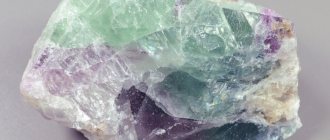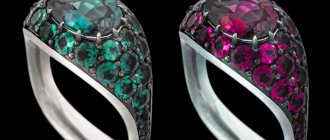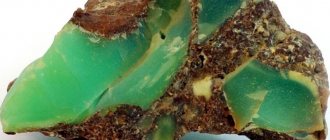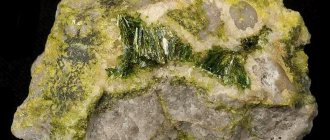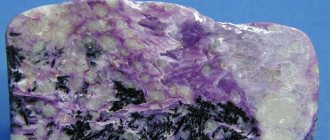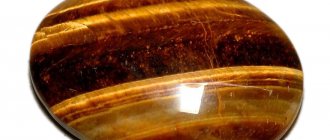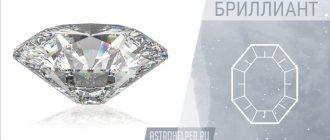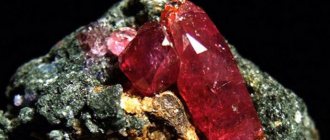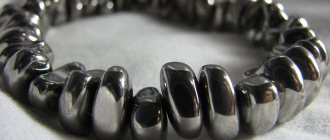Fluorspar is the mineralogical name for fluorite. The stone got its name back in the 16th century due to the fluidity property it possesses. Fluor is translated from Latin as “fluid.” And the “father” of mineralogy, George Agricola, awarded him this name.
But this does not mean at all that the scientist discovered this stone. The mineral fluorite has been used by humanity for many centuries. In ancient Rome, vases made from this mineral were highly valued. But then he was called differently - murin. And the cost of such things was commensurate with the price of gold items. None of the vases have survived; we can judge their beauty only from descriptions in the works of Pliny the Elder. In Saxony, miners called this stone the ore flower for its unusual color. Objects and jewelry found in the Czech Republic and Ukraine are more than 100 centuries old.
There are many deposits of this mineral. The largest are located in Germany, Scotland, England, China, and the USA. In Russia, it is mined in the Primorsky Territory, Buryatia and Transbaikalia. The most important export suppliers are Mongolia, China and Kazakhstan.
Story
Bowls, vases, and other mineral utensils that glow from the inside were made by masters of ancient Greece. But it was available only to the rich.
In the Middle Ages, alchemists became interested in stone. The most famous of them (he is also the father of mineralogy), Gregory Agricola, came up with the name for the mineral. Since the stone could be melted in an ordinary crucible, it was dubbed fluorite (“fluer” is Latin for “flowing”).
At the same time, this is the name given to the effect of the glow emitted by a mineral under ultraviolet light or when heated - fluorescence. Today it applies to all minerals.
The properties of fluorite - glowing when heated, creating poisonous gas and exploding - have given it the reputation of the “devil’s stone”.
Physico-chemical characteristics
From a chemist's point of view, the mineral fluorite is calcium fluoride. The only mineral whose chemical formula contains fluorine as a component.
When dissolved in hydrochloric acid, it releases toxic gas.
| Formula | CaF2 |
| Color | White or colorless, violet, blue, blue-green, yellow, brown-yellow or red |
| Stroke color | White |
| Shine | Glass |
| Hardness | 4 |
| Cleavage | Perfect by {111} |
| Kink | Stepped |
| Density | 3.18 g/cm³ |
| singonia | Cubic |
| Refractive index | 1,433—1,435 |
Heated crystals glow in the dark, and the mixture with H2SO4 leaves a lasting trace. When heated, they become discolored, but restore color when exposed to X-rays.
Fluorite crystal
Description
Fluorite looks amazing, but no more than 3% of the mined volume is used in jewelry and souvenir production.
The crystal has a huge number of different shades with rainbow tints: pink and reddish, yellow, blue, purple, blue-black. This is a unique color palette, and is transparent or translucent.
In addition, colored stones are dotted with original patterns, numerous inclusions and stripes. Zoning is also common, i.e. the color may change from a brighter color to a less vibrant one.
Varieties
The following types of mineral are distinguished by color, structure and origin:
- Alpino. Octahedral crystals of red color, originally from the Swiss Alps.
- Antozonite. Dark purple stone. When cracked, it releases fluorine and a specific odor. Radioactive. These properties give rise to other names: fluorspar, radiofluorite.
- Derbyshire John . Instances of blue tones. Usually the structure is striped: blue, blue or purple stripes alternate with white, grayish, yellow. Other names: Derbyshire spar/Blue John/Blue John. Named after the place of production - Derbyshire in the UK.
- Chlorophane. Stones with the effect of intense green fluorescence when heated.
- Lithos-lazuli. A stone with red (purple) concentric stripes.
- Ratovkit . Usually loose purple stones of sedimentary origin.
Species in which calcium in fluorite is replaced by other elements:
- yttro-fluorite – yttrium;
- cer-fluorite – cerium.
Local names: green stones - “green John”, Transvaal or South African emerald.
Production
Fluorspar is one of the most common minerals. Its deposits are often found in dolomites, limestones, and hydrothermal ores. It is also accompanied by some other stones: quartz, galena, calcite, gypsum, apatites, topazes, tourmalines, etc.
The largest known deposits are located in the southeast of Germany, England, almost everywhere in Central Asia, China, the USA, Central America, as well as in Transbaikalia, Buryatia, and the Primorsky Territory. Usually there are specimens of 5-6, less often up to 20 centimeters. The largest exporters of the mineral are Mongolia, China and Mexico. Kazakhstan is also an important supplier of optical fluorites.
Where is the stone used?
Fluorite is used in “serious” sectors of the economy and the beauty industry.
Jewelry
Semi-precious fluorite is one of the most “fertile” stones for jewelers. The range of colors and aesthetic standards allow us to create jewelry to suit any request.
Particularly good are necklaces, bracelets, beads and sets made of multi-colored minerals and beads of different colors.
For fluorite products, choose a frame that harmonizes in color: silver, cupronickel, rhodium-plated brass, “golden” jewelry alloy.
Fish figurine made of natural fluorite
Decor
The stone, which is malleable in processing, is used for small plastic items, souvenirs, and tableware.
They decorate photo frames, bonbonnieres, and other cute little things. They are not cheap, so they often fall into the category of VIP gifts.
Fans of esotericism take apart balls, pyramids, and body amulets: pendants or fluorite crystals.
Other areas
Raw materials of non-jewelry standards have found application in industry:
- Chemistry. The acid of the same name is obtained from fluorspar. This is the source for compositions that leave an indelible matte mark. The most famous application is the “stained glass” decor of mirrors and glass.
- Metallurgy. The addition of a mineral lowers the melting point of the ore.
- Optics. Colorless transparent fluorites become lenses for cameras (specialists from the Japanese brand Canon were the first to do this) and night vision devices.
Collectors are offered a wide range of raw stones: crystals, agglomerates, druses of different shades and deposits.
Application area
In the 21st century, murine has found application in various fields of industry:
- Hydrofluoric acid is obtained from fluorite ore. It is used to create engravings and is added to enamels. They are used in decorative arts and in individual construction to cover indoor surfaces.
- Transparent crystals are used to make various lenses.
- Ordinary minerals are used to make heat-resistant, durable polymers.
No more than 5% of the extracted minerals are used in jewelry.
Price
Anyone can buy fluorite products.
The cost is affected by the number and dimensions of the stones and the material of the frame (price/rub.):
- bracelet – 500–700;
- beads – 950 – 2,450;
- earrings (jewelry alloy) – 360;
- earrings (silver) – 1,560;
- ring (silver) – 1,240 – 1,590;
- figurine of a dog (height 10–15 cm) – 14,200 – 32,700;
- tumbling (2–4 cm, piece) – 240–350;
- agglomerate (24x14.5x15 cm) – 156,000.
Fluorite of Chinese origin is predominantly used as jewelry and collection material.
Price
Fluorite is an inexpensive mineral, so anyone can buy it. Examples of prices in Russian online stores:
- bead (8 mm) - 20 rub. ;
- tumbling (2 cm) - 160 rub. ;
- earrings (brass) - 230 rub. ;
- cabochon (26 x 22 x 11 mm) - 270 rub. ;
- crystal (8 cm) - 708 rub. ;
- intergrowth of crystals - 840 rub. ;
- necklace— RUB 1,163. ;
- rosary (30 grains, d=10 mm) - 1,220 rub. ;
- ball (4.5 cm) - RUB 2,316. ;
- figurine “Owl” (15 cm) — RUB 13,000.
How to identify a fake
In the case of fluorite, the situation is twofold: it is counterfeited and passed off as expensive gems.
Imitation fluorite
Instead of stone, they offer painted glass or plastic. A fake can be identified by several signs. Unlike glass, fluorite is easier to scratch and does not immediately heat up in your hands. The mass helps to distinguish it from plastic: lightness means a fake. When heated by heat, natural stone glows under an ultraviolet lamp.
Fluorite as an imitation
Due to its external similarity, fluorite serves as a “double” for expensive stones.
This is evidenced by the unofficial names of fluorites:
- yellow fluorite – false (or pseudo) topaz;
- red or pink – false (pseudo) ruby;
- purple – false (pseudo) amethyst;
- green – false (pseudo) emerald;
- blue or light blue – false (pseudo) sapphire.
They were not invented out of nowhere, so when choosing jewelry, you should check the documents for the precious stones.
Place of Birth
Fluorite stone is a fairly widespread mineral in nature, and at the moment it is also mined.
It is a sedimentary rock, so the presence of limestone or dolomite rock, or a geothermal source is necessary for its origin.
The mineral was discovered in Europe, the USA and Canada, as well as in Russia and the CIS countries. Its production in large volumes is carried out on the shores of the White Sea and in the Suran deposit.
How to wear jewelry
The color richness, strong or moderate shine of the stone allows you to choose accessories for ladies of any age and for any occasion.
Men's line: inserts of cufflinks, tie clips, rings. They look non-trivial and solid.
Magicians say that the most powerful “helpers” are a ring, a ring on the ring finger, and earrings. Gold or silver.
The abundance of the stone (especially in beads or bracelets) requires caution: fluorite is able to take the initiative, making a person only a performer.
How to care
Fluorite is fragile, its hardness on the Mohs scale is below average, so you need to carefully care for it:
- The stone may not tolerate frost or heat. The acceptable temperature range is from -4 to +38°C.
- Remove dirt with warm water, a damp cloth and baby soap or a similar mild product.
- Before doing housework, decorations are removed.
- For jewelry, it is better to select a separate box or durable box so that the inserts do not get scratched.
Fluorites, used in magic or healing, cleanse energy dirt. It is enough to rinse them with running water.
Care
Due to its fragility, fluorite must be cared for quite carefully.
Among the basic rules for caring for stone are:
- Do not allow a significant decrease in temperature (below -5), as well as an increase (above +40).
- Dropping a stone or impacts may cause the crystal to crack.
- Storage should be carried out in a soft case or case, as it is easy to scratch.
- When cleaning, do not use any special chemicals, not even soap. Cleaning is limited to a damp cloth, which is used to wipe the stone.
In order for fluorite to be freed from accumulated bad energy, you need to place it under running water, and it can be “charged” from the sun. It is enough to do this once a week.
Therapeutic effect
Lithotherapists have identified the healing properties of fluorite:
- Increasing stress resistance, neutralizing depression, getting rid of insomnia and nightmares.
- Treatment of epilepsy, atherosclerosis. Help in recovery after a stroke.
- Strengthening bones, teeth, joints.
- Acceleration of body regeneration after serious illnesses, surgery or injuries.
- Regulating the functioning of the kidneys and the genitourinary system as a whole.
- Relief of conditions caused by weather dependence (migraines, aches).
- Help for the eyes: rest, sharpening of vision (especially green stones).
Fluorite is of great importance as a stone of beauty. Massage with a roller or balls rejuvenates the skin.
Wearing fluorite products or raw talisman stones strengthens the immune system.
Magic properties
The inner glow of the stone could not leave sorcerers and ordinary people indifferent. The first tried to convince the second that this was the work of the devil and it was better not to have anything to do with the gem.
For modern man, the magical properties of fluorite are also useful:
- This is an attribute of everyone who studies. The stone encourages analytical research and helps to focus on the main thing.
- Promotes the discovery of talents and abilities. Helps you realize them by finding your life’s work.
- Destroys stereotypes, allowing you to evaluate yourself and others in a new way.
- This is a favorite tool for fans of meditation and other energy practices.
- The mineral provides a shield to external influences. Especially attempts to take control of a person’s consciousness.
Fluorite attracts negative energy on all planes. Both mental negativity and radiation from gadgets. Therefore, it is useful to place a pebble near a computer, TV, or microwave.
Modern magicians know: by peering into a fluorite sphere, you can see the future.
Compatibility
If the jewelry is used as a magical or healing artifact, the proximity of fluorite to other gems matters:
- The mineral is fully compatible with amethyst, rock crystal, quartz, lapis lazuli, tourmaline, and citrine. It does not conflict with other “air” minerals.
- “Enmity” depending on the color. White is incompatible with hematite, cat's eye, malachite; green – with diamonds, onyxes.
Antagonist stones weaken each other's magic, nullifying the magical power of the talisman. They are not combined in decorations. It is not recommended to even store it in one box.
What is the price
The price of fluorite jewelry is low. Key rings and cufflinks framed in cupronickel or silver sell for 8-10 dollars, more massive items for 15-30. The cost of a necklace or beads reaches 45-50 dollars.
The unusual stone fluorite has acquired great importance in human society. It is known not only to fashionistas of all ages, but also to metallurgists, chemical industry workers and lens manufacturers. Doctors use the crystal in lithotherapy and massage. Yogis and psychics - in rituals and meditation.
Fluorite and Zodiac
Fluorite is ideal for Gemini and Virgo. For the first ones, the stone will gently force you to think about the meaning of life. The latter will be helped to understand things that previously did not receive attention, and to be more merciful to others.
According to the horoscope, the mineral is also useful for other zodiac signs:
- Energetically weak Pisces will be recharged so much that they will be able to share their strength with others.
- Capricorns will receive an impulse for creativity.
- The stone is suitable for Aries who strive for spiritual heights.
- Ambitious Aquarians will be able to prove their personal importance and become stronger physically.
Table of fluorite compatibility with zodiac signs (“+++” – fits perfectly, “+” – can be worn, “-” – is strictly contraindicated).
| Zodiac sign | Compatibility |
| Aries | +++ |
| Taurus | + |
| Twins | +++ |
| Cancer | + |
| a lion | + |
| Virgo | +++ |
| Scales | + |
| Scorpion | + |
| Sagittarius | — |
| Capricorn | +++ |
| Aquarius | +++ |
| Fish | +++ |
For other signs, fluorite is more of a decoration. Only Sagittarius needs to be careful: the insidious stone is capable of “editing” incoming information.
